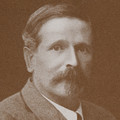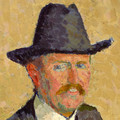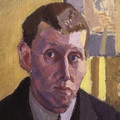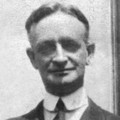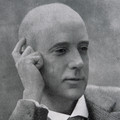Charles Ginner, ‘The Camden Town Group’
The Studio, November 1945, pp.129–36.
THE CAMDEN TOWN GROUP
By CHARLES GINNER, A.R.A., R.W.S.
HAROLD GILMAN was the prime mover in the formation of the Camden Town Group. It had come to pass that the New English Art Club had been rejecting his works as also the works of painters he most admired. Something had to be done, and when possessed with the idea that some wrong needed redressing he was not one to let the matter rest until something had been done. He discussed this, to him serious, question with Spencer Gore and Robert Bevan, and he consulted his old friend Walter Sickert. What was to be done? Capture the New English? Form a new society? Capturing the New English was soon found to be out of the question. Gore, for one, was opposed to this idea, and Sickert was of the very decided opinion that it was impossible.
The result of these numerous conversations was an intimate meeting over a dinner at Gatti’s, and that evening the decision, after a lengthy discussion, was arrived at to form a new society. Gilman was jubilant and as we had indulged in a good dinner with abundance of wine to wash it down (this was 1911) Sickert, striding out of the restaurant ahead of us, turned and waved his arm exclaiming “We have just made history”. Discussions continued at No. 19, Fitzroy Street, where a group of painters, formed some years previously by Walter Sickert, held Saturday afternoon “at homes”. A second, slightly larger meeting took place at the Criterion, and here the new society could be said to have been safely launched with the names finally decided of several artists to be invited. This [end of p.129] resulted in a full meeting held at yet a third restaurant, this time in Golden Square, where Walter Sickert himself was responsible for the christening of this new venture as “The Camden Town Group”. Spencer Gore was elected President and J. B. Manson Secretary.
But there was one point that still remained unsettled and this was the question of the election of Wyndham Lewis, whose name had caused much opposition in certain quarters of the group, as he was at that period touching the fringe of cubism, anathema to certain of the members. But they had to reckon with Gilman who was determined that Wyndham Lewis should be one of the select few, with the result, almost foreseen, that he was duly elected.
Another serious point arose, the question of the membership of women. Gilman, strongly supported by Sickert, was in full opposition to such a proposal as he contended that some members might desire, perhaps even under pressure, to bring in their wives or lady friends and this might make things rather uncomfortable between certain of the elect, for these wives or lady friends might not quite come up to the standard aimed at by the group. So it came about that the fair sex found the portals of the Camden Town Group closed on them.
This prolonged hatching of the precious egg finally produced the following sixteen members:– Walter Bayes, Robert Bevan, Malcolm Drummond, Harold Gilman, Charles Ginner, Spencer Gore, J. D. Innes, Augustus John, Henry Lamb, Wyndham Lewis, M. G. Lightfoot, J. B. Manson, Lucien Pissarro, W. Ratcliffe, Walter Sickert and Doman Turner. Duncan Grant, coming in after the first exhibition, brought the number up to seventeen.
The Group was formed – but where was it going to exhibit its works? Here the all powerful influence of Sickert was called in. Walter Sickert was on friendly terms with Mr. Clifton, who at that time was running the Carfax Galleries in Bury Street, St. James’, and Sickert with his engaging talk and charming manners lured Mr. Clifton into giving the Camden Town Group its exhibitions, and at this Gallery the exhibitions were held to the number of three.
It would not be giving a true and faithful view of all the motives which were urging the original founders of the group if I were to leave on the reader the impression that the formation of The Camden Town Group was entirely due to the rejection of works by the New English Art Club.
They had aspirations and held artistic ideals which they desired to bring to the notice of the art-loving public, and collected a group which was to hold within a fixed and limited circle those painters whom they [end of p.130] considered to be the best and most promising of the day. Had not Sickert formed his little “coterie” of 19, Fitzroy Street, with, in all probability, somewhat the same ideas quite apart from his cherished hope that the artist could sell direct to the public – a cherished hope he soon abandoned.
I cannot claim to have been more than an onlooker at the formation of the Camden Town Group as at this period I had only just been invited to join the Fitzroy Group a few months after my arrival from Paris in the year 1910. But having been taken under Gilman’s wing I was present at most of these early discussions and attended the very first meetings.
At that time, as a newly fledged member of No. 19, I gazed on in much awe at Sickert’s air of “grand seigneur”, at Gilman, the incorruptible, firmly determined in his ideas and brooking no compromise; Gore, kind-hearted, smoothing out difficulties, friendly with one and all and pouring little drops of oil on the rough surfaces left in Gilman’s wake; Lucien Pissarro, worshipping his father Camille and coming out with his recurring sentence [end of p.131] [beginning of p.134] un peu plus de variétés to impress us with the importance of a full orchestration of colour; J. B. Manson fighting Pissarro’s battles; Robert Bevan who had been at Pont Aven with Gauguin; and Walter Bayes who was then writing for The Athenæum and whose paintings Sickert so greatly admired.
The first exhibition was held in June 1911. It caused a considerable stir in the Press of the day.
Gilman was still influenced by Sickert, but a somewhat higher key of colour was creeping in and he was already beginning to expound his contempt for “mud”, as he termed it, in painting. He held firmly to the juxtaposition of colours in firm small touches but had nevertheless the appearance of “pointillism” which marked the work of Spencer Gore whose vibrating colour had a rare sensibility and delicacy which showed to great advantage in his luminous Music Hall scenes. Robert Bevan was still immersed in his cab yard scenes but was already beginning to concern himself more with large spacial compositions than his friends Gore and Gilman. Walter Bayes could be looked to for a remarkable and learned sense of design. Sickert was at his peak with his low-toned Camden Town and Dieppe pieces, and Wyndham Lewis impressed us with his bold insistence on a firm and rigid design soon to culminate in his abstract compositions of the 1914 war period.
The December following brought on the second exhibition of the Camden Town Group with Duncan Grant showing works. It was at this period that Roger Fry launched on an astonished and angry London his first Post-Impressionist Exhibition which caused Robert Ross, the then critic of the Morning Post to cry out with some vehemence that one and all of these paintings should be consigned to the flames.
Harold Gilman was not at first enthusiastic; he gave first place to Gauguin and argued much against Van Gogh. But he soon altered his view and developed a great admiration for this Dutch post-impressionist master, placing Gauguin, his first love, last in the famous trinity – Cézanne, Van Gogh, Gauguin. Then came to light those works of Gilman with their rich-toned colour schemes, bold broad strokes of the brush [end of p.134] and thick impasto, greatly to the distress of Sickert. From the very first Spencer Gore more readily accepted the lessons that might be learnt and began to develop a broader vision in planes, and his pointillistic touch began to recede as a thing of the past. Robert Bevan, meanwhile, was developing a simplification of forms in an angular pattern of high-pitched colours from which towards the end of his life he was moved to a more intimate vision.
The third and last exhibition of this group took place in the December of 1912. Sickert’s friend Clifton, finding these exhibitions rather more of a liability than an asset, decided to drop the venture. This caused some consternation in the circle, and as a result of much discussion Gilman and Gore contacted Wyndham Lewis and his group, and the first nucleus of a new group was formed.
Other artists were approached and a large meeting eventually took place at No. 19, Fitzroy Street. Here, unless my memory has played truant, I have a vision of Jacob Epstein, during a discussion on the naming of this new society, leaning against the mantelpiece and saying to the assembled company, amidst general approbation, “Let us call it ‘The London Group’ ”.
Editor’s Note: The formation of The London Group and its subsequent history was the subject of an article in The Studio, February 1945, now entirely out of print.
***
Note:
The illustrations in Charles Ginner’s article are as follows (captions are provided in the original style):
Robert Bevan (1865–1925). “Houses in Sunlight, Hampstead”. (Courtesy: Lefèvre Gallery) [p.129]
Walter Bayes. “Near Avignon”. (Courtesy of Arthur Tooth & Sons, Ltd.) [p.130]
Walter Richard Sickert (1860–1942). “Bath”. (London: Tate Gallery, Lady Henry Cavendish Bentinck Bequest) [p.131. Tate N05087]
J. B. Manson (1879–1945). “Lucien Pissarro”. (Manchester City Art Gallery) [p.131]
Charles Ginner, A.R.A., R.W.S. “Paper Mill House”. (Courtesy of Edward Le Bas, Esq.) [p.132]
J. D. Innes (1887–1914). “Arenig, North Wales”. (London: Tate Gallery) [p.132. Tate N04385]
Spencer F. Gore (1878–1914). “Brighton, 1913”. (Courtesy: Lefèvre Gallery) [p.133]
Lucien Pissarro (1863–1944). “Route de Poulfenc à Riec” [p.133]
Henry Lamb. “Portrait of a Young Woman” Purchased by the Borough of Southampton. (Courtesy: Leicester Galleries) [p.134]
Wyndham Lewis. “T. S. Eliot.” (Courtesy: Leicester Galleries) [p.134]
Augustus John, R.A. “Eve Balfour” [p.135]
HAROLD GILMAN (1878–1919) “INTERIOR” (Courtesy of Edward Le Bas, Esq.) [p.136]
How to cite
Charles Ginner, ‘The Camden Town Group’, in The Studio, November 1945, pp.129–36, in Helena Bonett, Ysanne Holt, Jennifer Mundy (eds.), The Camden Town Group in Context, Tate Research Publication, May 2012, https://www

